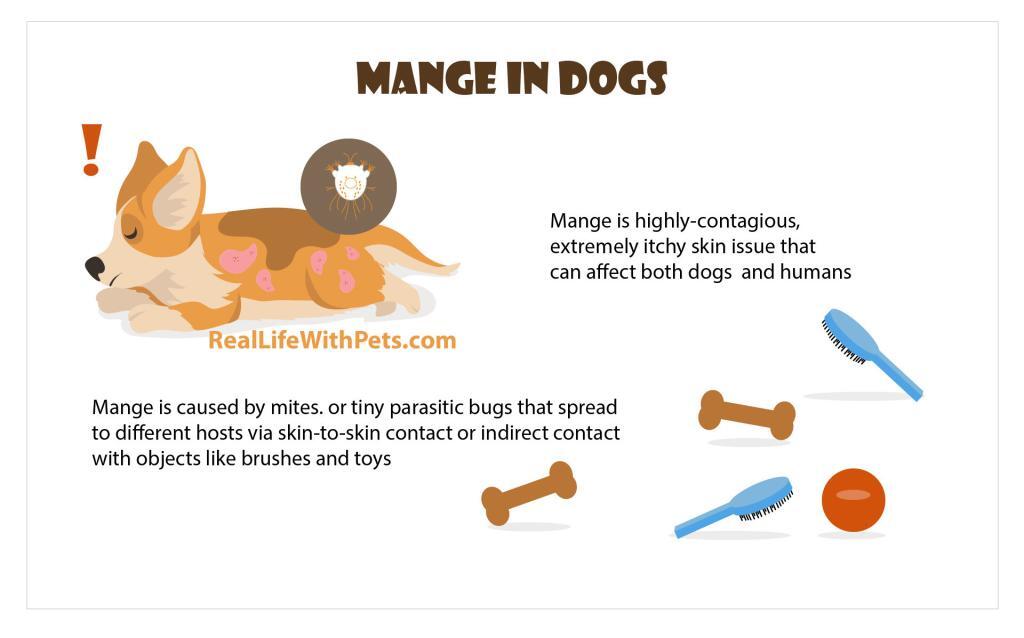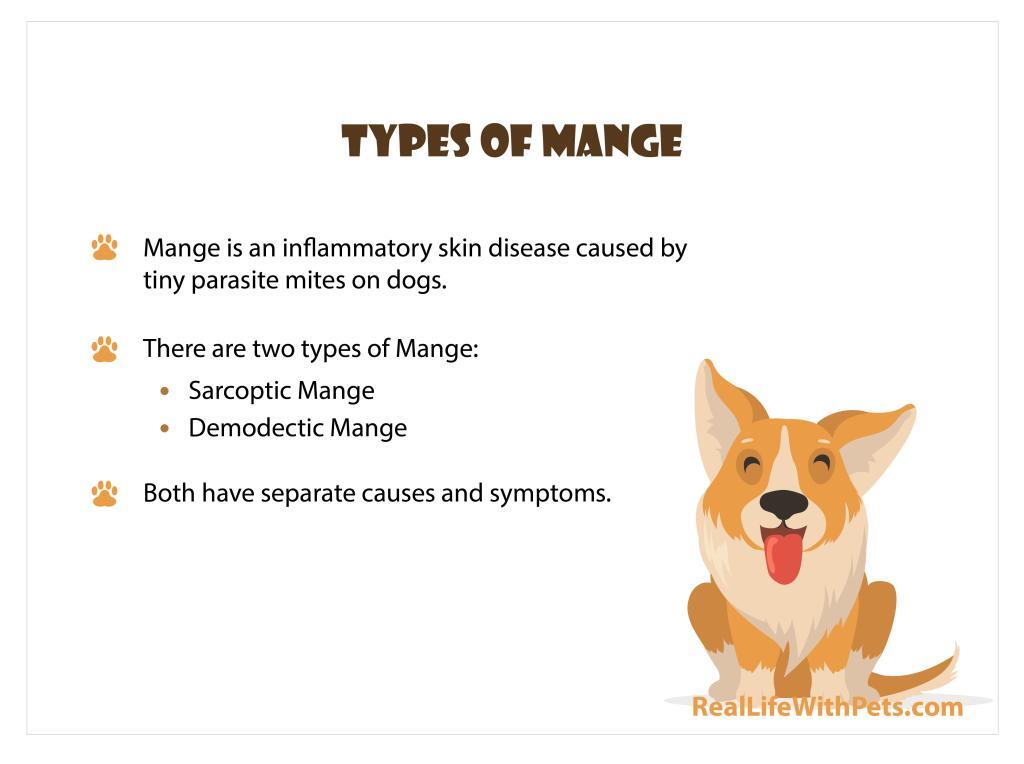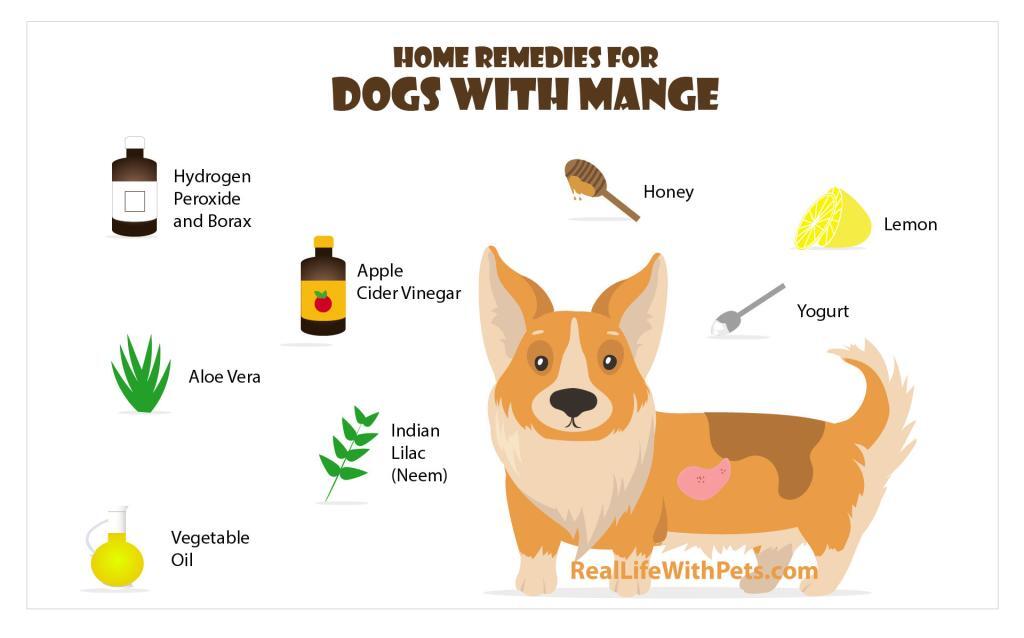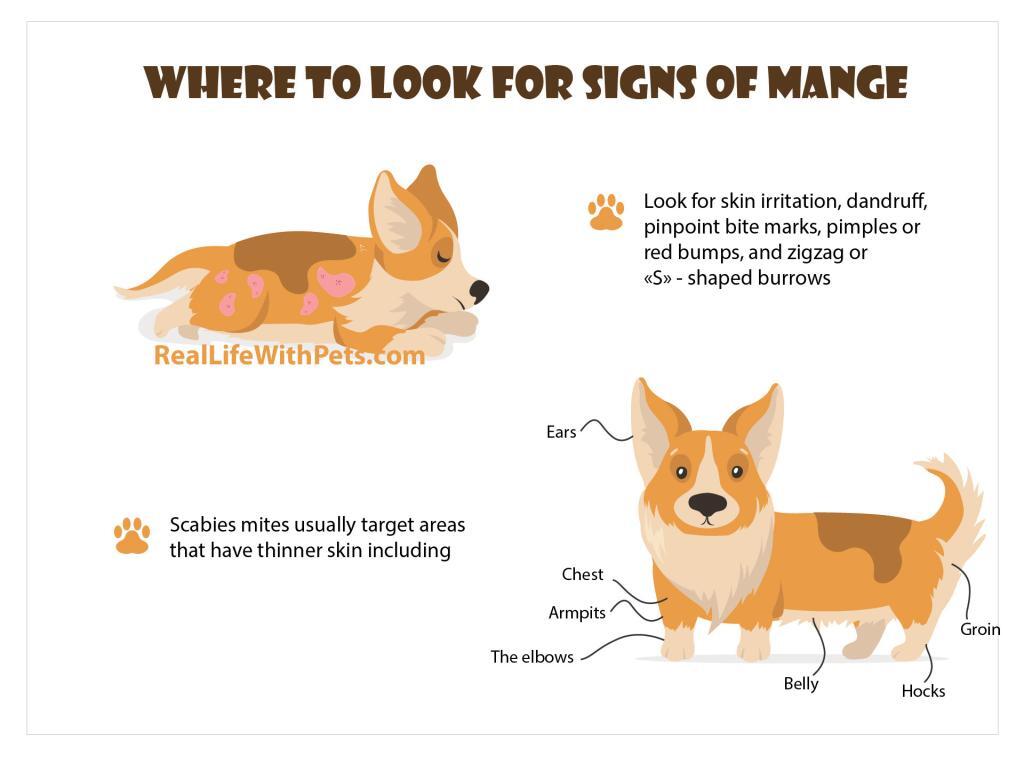Table of Contents
What can be more distressing than mange in dogs? It is an illness caused by mites that infest the animal’s skin. The term is derived from the French word mangeue. It translates into English “to eat or itch.” There exist two types of the disease. You will recognize it through your dog’s apparent skin changes and constant itching. One of these types can even be infectious to humans.
But you can prevent mange and even treat it with the help of home remedies that are easy to make and apply. This article will guide you through the main symptoms of the two types of mange, home remedies for mange in dogs, their use, and dosage.
What Is Mange in Dogs?
Mange is a skin disease found among mammals. Domestic animals like cats, dogs, kittens, and puppies can catch the mange from a sick animal. Dogs are especially prone to developing mange. They can suffer from two types of disease, each of which has its causative agent. In both cases, the disease development may be caused by mites.

If you suspect mange in your pet, the most alarming sign is itching and abnormal changes in how your pet’s fur looks. Therefore, it is crucial to confirm the mange at the vet’s and define the exact type of the illness.
Types of Mange in Dogs
When you suspect mange, identifying the type of the illness is crucial. Not only because each type requires different treatment but also because, in some cases, you may get infected by one of them. There are two main varieties of the disorder – sarcoptic and demodectic. Let’s discuss both types to learn their distinguishing features.

Sarcoptic Mange
Sarcoptic mange in dogs is caused by Sarcoptes scabiei or itch-mites. These are microscopic mites that are oval-shaped and light-colored. These parasites fix on the victim’s skin and irritate it terribly. Female mites lay their eggs that hatch in about three weeks. Then the young feed on the host’s skin. The illness is hazardous because humans can become infected with it, too.
Symptoms of Sarcoptic Mange in Dog
Symptoms usually appear from about ten days to eight weeks after contact with an infected dog. The first signs of the illness can be found on the margins of the ears, elbows, chest, hocks, and belly. They can quickly spread if left untreated. Here are the most common symptoms of sarcoptic mange:
- redness and rash;
- extreme itchiness;
- thick yellow crusts;
- hair fall out;
- bacteria and yeast infections;
- lymph node inflammation (advanced cases);
- thickening of the skin (advanced cases);
- emaciation (extreme cases).
The main and the most irritating symptom of mange in dogs is terrible itching. The infected animal itches constantly, and its skin becomes covered with hairless patches, scratchings, and scabs. Therefore, they can be considered a source of infection as well. That’s why you ought to treat your pet with a mange medication for dogs or cats as quickly as possible.
How Is Sarcoptic Mange Diagnosed?
Usually, veterinarians take one or more skin scrapings and examine them under a microscope. It may happen that there will be found no mites in the skin samples, although the symptoms strongly show an infestation.
Demodectic Mange
Demodectic mange is caused by Demodex canis, another group of mites that usually infest sebaceous glands of the hair follicles. The fact is that all dogs have these parasites right from birth. It is considered normal since a healthy animal’s immune system will not allow them to breed too much. The illness starts developing when the Demodex mites begin to multiply uncontrollably.
Demodex canis are passed to newborn puppies from their mothers. The mites live deep in hair follicles, causing no harm. In addition, an immune system keeps the number of mites in check. So, who is at risk of demodectic mange? Check the following list:
- Puppies with a weak immune system.
- Sometimes patches of Demodex may appear in young, healthy dogs, but they go away on their own or with localized topical treatment.
- Sick, elderly, neglected, or stray dogs with a weak immune system, for example, conditions like diabetes or cancer can impair immune function and lead to this form of mange.
Symptoms of Demodectic Mange in Dog
An overall Demodex infestation of hair follicles results in fur discoloration and gradual loss of hair that can end up with a total fur fall-off. Also, when touching your pet’s skin, it can be oily. Itching is not so annoying in this case. However, it annoys the animal, so the red crusts also occur. The entire body may be covered with redness, infections, swelling, scaling, and crusts in generalized cases. Often the dog loses most, if not all, hair.
Types of Demodectic Mange
Three types of demodectic mange are known.
1) Localized mange happens when the mites proliferate in only 1 or 2 small areas, usually on the face. As a result, scaly, isolated, bald patches look like a polka-dot pattern. It is often found in puppies; almost 90% of cases disappear without treatment.
2) Generalized demodectic mange affects larger areas of skin, sometimes the entire body. As a result, the skin may be very itchy and foul-smelling. The course of treatment for the dog depends on the age at which the disease develops.
3) Demodectic pododermatitis is a type of mange confined to the foot and is often accompanied by bacterial infections. It is one of the most resistant forms of mange.
Diagnosis of Demodectic Mange
The vet takes a skin scraping and examines it under a microscope.
Breeds Prone to Developing Mange
Dogs younger than 18 months are prone to localized demodectic mange, which often does not require treatment. Generalized demodectic mange is more serious found in the following breeds:
- Collie
- Old English Sheepdog
- Pointer
- Dachshund
- Shar-Pei
- Pug
- German Shepherd
- Chow Chow
- Doberman Pinscher
- Afghan Hound
- Chihuahua
- Great Dane
- Beagle
Regardless of breed, older dogs with underlying medical conditions are also more prone to developing the disease. The factors which affect mange include:
- intestinal worms;
- cancer;
- anxiety;
- diabetes;
- pregnancy;
- hypothyroidism;
- heartworms;
- medications.
Home Remedies For Mange in Dogs
Mite infestation of any type is a dangerous state for your pet. So, a mange treatment in dogs should be used immediately after the diagnosis. The good news is that ordinary low-cost homemade remedies can provide positive effects.

Benzoyl Peroxide
The top popular mange home treatment in dogs is a Benzoyl peroxide shampoo. Its main advantage is that you do not need to give your pet pills or injections. The therapy is natural, but still, it does help to treat both mange types. You can wash your dog every day until the symptoms disappear. However, you may consult the vet to get personalized advice.
Apple Cider Vinegar
How to treat mange in dogs at home with apple cider vinegar baths? First, combine it with borax half-and-half. The most common dosage includes ½ cup of vinegar and ½ cup of Borax. Ensure complete dissolving of Borax, and do not let your puppy lick the liquid since Borax can harm its stomach. You can also add apple cider vinegar to your pet’s water. The dosage is one tablespoon to 20 kg of body weight.
Olive Oil
Plant oils can be pretty effective in getting rid of mites. Vets recommend rubbing olive or almond oils into the infested areas. This procedure will block oxygen entry so that mites will be smothered. In addition, oil olive softens the skin and reduces itching.
Honey
Honey is famed for its healing properties. It produces antibacterial, antiseptic, and antioxidant effects. Put it on your pet’s scabs, and you will soon notice improvements. The only drawback is the extreme stickiness of this remedy. However, getting messy is worth your while in this case.
Aloe Vera
Another itch-relieving remedy is aloe vera. This plant’s juice is toxic for mites, but you should know it will also harm your animal when it gets to its gastrointestinal system. Nevertheless, you can apply freshly juiced Aloe Vera to the irritated skin to cancel redness and reduce the itching.
Yogurt
Does yogurt help to treat mange? Does it work as a skin remedy at all? Yes, it does. Yogurt is rich in bifid bacteria and has a sticky consistency. Applying it to the affected areas will soften the irritation and cut the mites off the oxygen. Use unflavored yogurt.
Lemon
Like any citrus, lemons produce an excellent antiseptic effect. The most effective dosage is the juice of 1 lemon mixed with a liter of water. Add some garlic to boost the mixture’s efficacy.
When Natural Treatments Aren’t Enough
Home treatment of mange can give quick results. But it may be insufficient, especially against sarcoptic mange. So when you cannot get rid of the illness with the help of homemade remedies, it’s time to use medicines developed to fight mange effectively.
Mange Treatment in Dogs
There exists a broad range of anti-sarcoptic means that effectively fight mites.
Amitraz and lime-sulfur are commonly used medications, as well as fipronil, selamectin, imidacloprid, and moxidectin. In addition, there are various oral mange medications for dogs in the form of tablets, liquid, or soluble powder. However, the best results can be achieved with the help of sarolaner, afoxolaner, milbemycin, fluralaner, etc.
|
Best Dog Mange Treatment |
||
|
Interceptor |
Sentinel |
Trifexis |
How to Prevent Mange in Dogs
We live in a world inhabited by megamillions of microbial organisms, some of which can be dangerous for your pets and even you. However, prevention is better than cure. This truism is especially topical for the mange problem, so let’s observe the optimal strategy for protecting your dog from this nasty disorder.
Feed Your Dog a High-Quality and Balanced Food
Each puppy needs proper care right from birth so the immune system can save the animal. Therefore, when you buy a dog, you should ensure a healthy diet for your pet during its life cycle. “Healthy” means diversity and high quality here. Be sure to supply your pet dog with enough protein and feed him with various meat sorts. In addition, the menu should include vegetables, fats, and minor nutrient elements such as omega-3 fatty acids.
Clean Dog Bed
There is an opinion that dogs have perfect hair that can protect them from colds and illnesses. However, most veterinarians recommend using various comfortable and warm-keeping things like a blanket or a dog bed, not only during cold seasons. But keep in mind that without regular cleaning, it can do more harm than good. So, make it a rule to wash a dog bed at least every two weeks.
Bathe Your Pet Regularly
Although there are so many dog breeds, a universal formula here will be bathing once a month. However, your pet may need an individual approach, and you may wash it as often as necessary. The only rule here is to keep its paws, muzzle, fur, and the rest of the body clean. Of course, you may also use special dog mange shampoos as prevention.
Visit Your Vet Regularly
Even if your pet feels well and you detect no symptoms of mange, you should keep in touch with the vet. Leastways, a specialist should examine your dog’s state of health once a year. Keep up with the vaccination schedule as well. Regular checkups with blood and urine tests will determine your puppy’s health.
FAQ
How Do Dogs Get Mange?
A dog can get mange from another animal infected with a specific group of mites. They parasitize on animal skin and cause skin and fur damage.
What Does Mange Look Like on a Dog?
Although there are two types of mange in dogs, they both cause itching and fur fall-off. The dog with a sarcoptic mange type suffers from these symptoms more intensively: the skin itches terribly and is gradually covered with irritated patches. The demodectic type irritates the infected animal less, but you may see your pet’s fur fall off, fade, or become oily.

How Can I Treat My Dog for Mange at Home?
Mange in dogs is easily prevented and treated in most cases. Lots of homemade remedies may help you. For instance, apple vinegar or olive oil produce a positive effect. However, you can use veterinary medicines from an anti-mite class if homemade treatment does not work.
What Is the Best Home Remedy for Dog Mange?
Mange home treatments include many options. However, the best solution will be hydrogen peroxide bathing combined with plant oil or lemon treatment.
How Do You Get Rid of Mange in a Dog Fast?
Olive oil, Aloe Vera, yogurt, lemon, honey, and apple cider vinegar are popular home remedies. The usage is described in this article.
How Long Does Mange Last on a Dog?
The disease usually disappears within a month in case you apply proper treatment.























